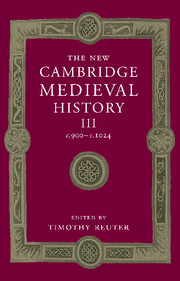Book contents
- Frontmatter
- 1 Introduction: reading the tenth century
- PART I GENERAL THEMES
- PART II POST-CAROLINGIAN EUROPE
- PART III NON-CAROLINGIAN EUROPE
- 19 European Russia, c. 500–c. 1050
- 20 Bohemia and Poland: two examples of successful western Slavonic state-formation
- 21 Hungary
- 22 Byzantium in equilibrium, 886–944
- 23 Bulgaria: the other Balkan ‘empire’
- 24 Byzantium expanding, 944–1025
- 25 Byzantium and the West
- 26 Southern Italy in the tenth century
- 27 Sicily and al-Andalus under Muslim rule
- 28 The Spanish kingdoms
- Appendix genealogical tables
- List of primary sources
- Bibliography of secondary works arranged by chapter
- Index
- Frontispiece
- Plate section
- Map 2: Archbishoprics and bishoprics in the early eleventh century
- Map 4: Germany
- Map 13: Byzantium in 1025
- References
21 - Hungary
from PART III - NON-CAROLINGIAN EUROPE
Published online by Cambridge University Press: 28 March 2008
- Frontmatter
- 1 Introduction: reading the tenth century
- PART I GENERAL THEMES
- PART II POST-CAROLINGIAN EUROPE
- PART III NON-CAROLINGIAN EUROPE
- 19 European Russia, c. 500–c. 1050
- 20 Bohemia and Poland: two examples of successful western Slavonic state-formation
- 21 Hungary
- 22 Byzantium in equilibrium, 886–944
- 23 Bulgaria: the other Balkan ‘empire’
- 24 Byzantium expanding, 944–1025
- 25 Byzantium and the West
- 26 Southern Italy in the tenth century
- 27 Sicily and al-Andalus under Muslim rule
- 28 The Spanish kingdoms
- Appendix genealogical tables
- List of primary sources
- Bibliography of secondary works arranged by chapter
- Index
- Frontispiece
- Plate section
- Map 2: Archbishoprics and bishoprics in the early eleventh century
- Map 4: Germany
- Map 13: Byzantium in 1025
- References
Summary
it was in 862 that the Hungarians first indisputably appeared on the European scene: an attack by Ungri on the kingdom of Louis the German is recorded for that year, and further attacks are recorded for 881 and 884, though it is very probable that Hungarians are already referred to in Byzantine sources in 837 or 838. The missionaries Cyril-Constantine and Methodius met Hungarians personally. Cyril encountered them around 860 in the Crimean Peninsula, while Methodius found them around 884 at the lower reaches of the Danube; he met the rex Ungarorum, perhaps Prince Árpád himself Regino of Prüm’s Chronicon for 889 says: ‘the hitherto unknown and incredibly fierce Hungarian gens has come from Scythia’, from where the Pechenegs had driven it, yet it is clear from the earlier encounters mentioned that the gens cannot have been completely unknown. Nevertheless, it is unproven, despite certain hypotheses and theories, that the Carpathian Basin was inhabited by Hungarian-speaking people earlier than the end of the ninth century. We have not as yet managed to excavate a complete Hungarian settlement from the tenth and eleventh centuries; the pits and huts dug into the ground which we have found could not have served as permanent dwellings. Apart from log cabins and tents it may be assumed that there were stone and brick buildings built in this period.
We are dependent on Frankish and Byzantine sources for our information, and these do not refer to the Hungarians by the name they used for themselves: Mogyeri or Magyaeri (‘Man of the Earth’; cf. gyermek, meaning ‘little man’, hence ‘child’). This brings us up against a fundamental problem of early Hungarian history, paralleled by the early histories of the Slavic and Germanic peoples. Contemporary written sources were compiled by ‘outsiders’ – Franks and Byzantines above all – who were not familiar with the Hungarians, and used older names and models drawn from more familiar peoples to describe them and their institutions.
Keywords
- Type
- Chapter
- Information
- The New Cambridge Medieval History , pp. 536 - 552Publisher: Cambridge University PressPrint publication year: 2000
References
- 1
- Cited by



